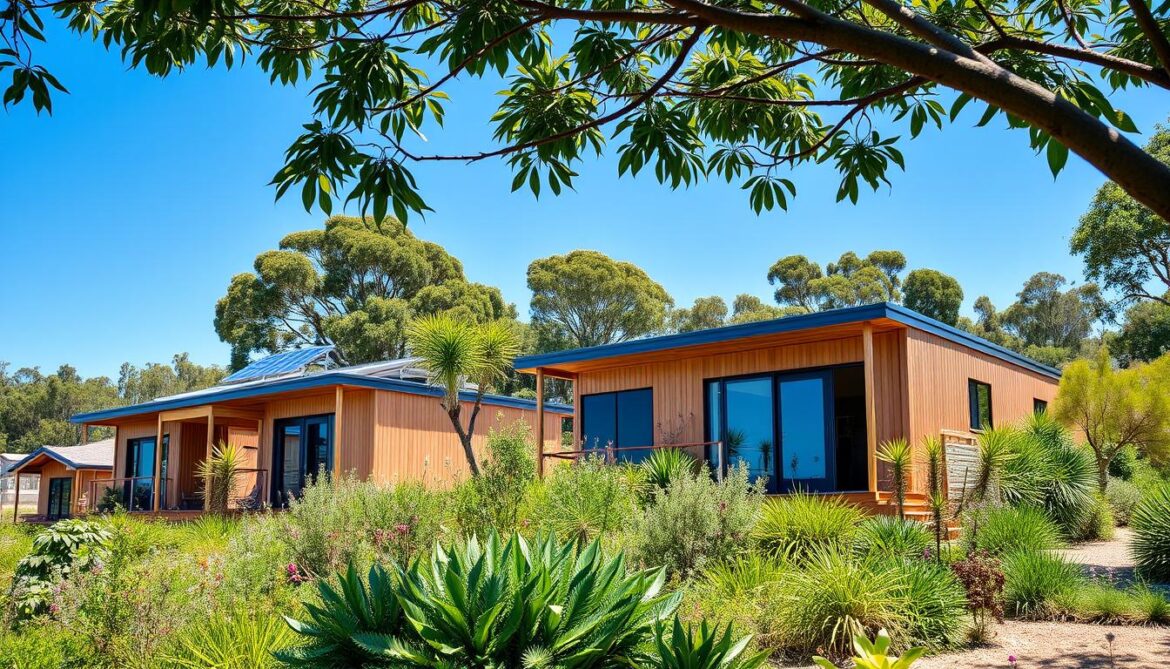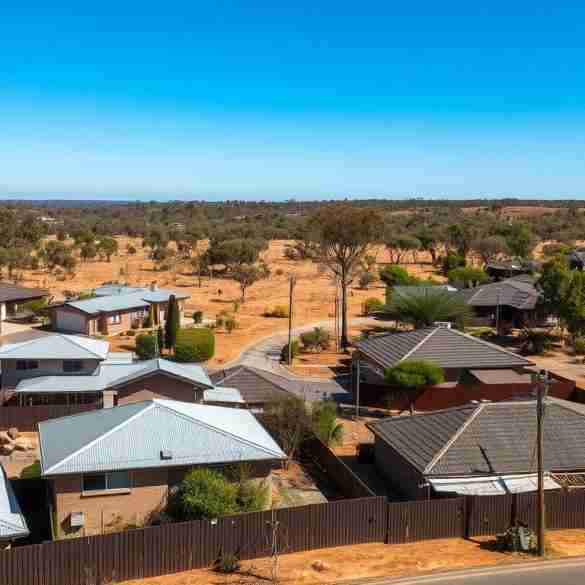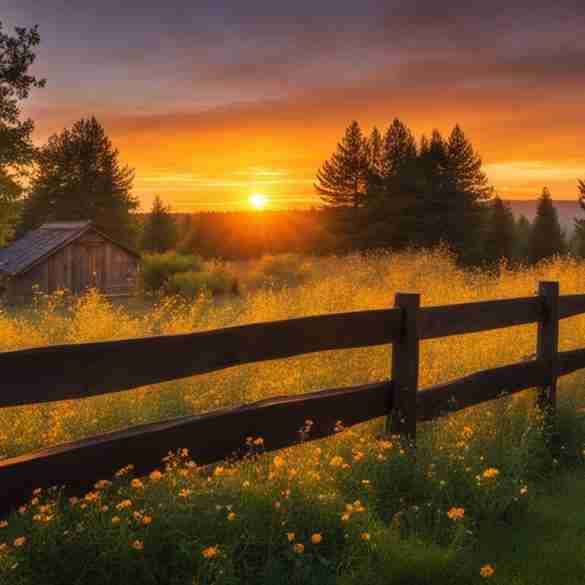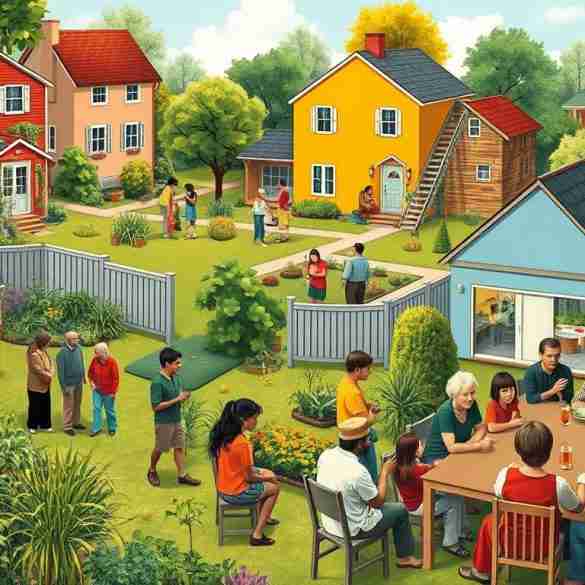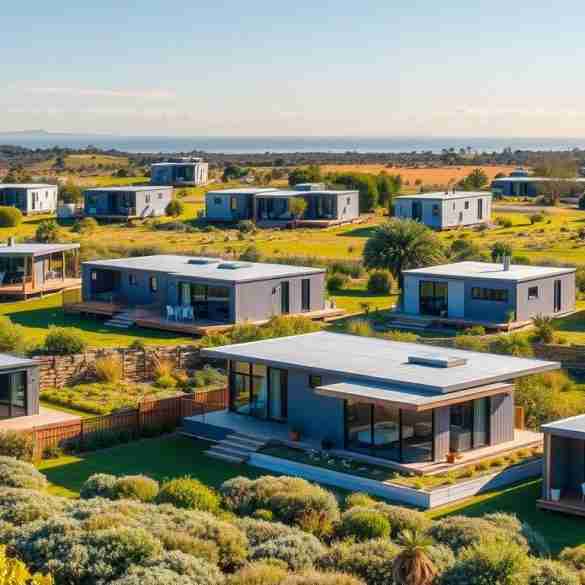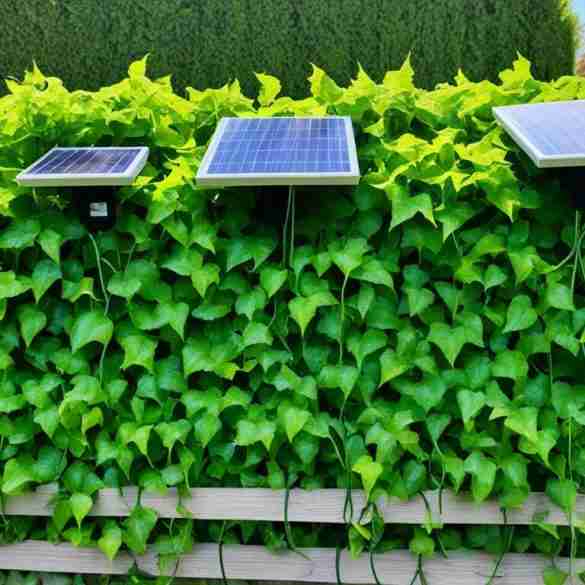Queensland’s housing scene is evolving. Sustainable modular homes are becoming a top pick for those who care about the planet. These homes are built to be both efficient and eco-friendly.
Modular homes are changing the face of Queensland’s homes. Companies like Ecoliv are at the forefront. They create homes that fit perfectly with Australia’s environment. Their EcoLiving range offers homes for all kinds of living.
These homes are more than just green. They’re made to keep you comfortable in Queensland’s varied weather. Whether you live by the coast or inland, there’s a modular home for you.
The move towards sustainable homes in Queensland is big. It’s all about caring for the environment and saving money at the same time.
Key Takeaways
- Sustainable modular homes are growing in popularity across Queensland
- These homes offer energy efficiency and environmental benefits
- Modular construction adapts well to Queensland’s diverse climate
- Companies like Ecoliv are pioneering sustainable home designs
- The trend aligns with increasing demand for eco-friendly housing options
Exploring the Rise of Sustainable Modular Homes in Queensland
Queensland’s climate and landscape are ideal for sustainable homes. The Sunshine State is seeing more affordable sustainable homes. These homes follow Queensland’s sustainable living practices.
Why Queensland Is Ideal for Sustainable Modular Housing
Queensland’s terrain and weather need different homes. Modular builders in Brisbane are creating innovative designs. These homes are built fast and are good for the environment, fitting Queensland’s goals.
Regional Climate Considerations for Modular Homes in Queensland
Modular homes in Queensland can handle tropical weather. They have:
- Efficient cooling systems
- Water-resistant materials
- Storm-resistant structures
Key Trends in Sustainable Modular Construction in Queensland
The modular housing industry in Queensland is growing fast. Trends include:
- Using eco-friendly materials
- Adding renewable energy systems
- Conserving water
Government Policies Supporting Modular Housing in Queensland
Queensland’s government supports sustainable modular homes. QBuild aims to deliver over 150 modern homes by mid-2024. This effort involves 11 MMC suppliers, showing the government’s dedication to green housing.
| Feature | Modular Homes | Traditional Homes |
|---|---|---|
| Construction Time | Faster | Slower |
| Environmental Impact | Lower | Higher |
| Customization | High | Moderate |
| Energy Efficiency | Higher | Lower |
Sustainable modular homes are the future of Queensland’s housing market. They offer affordability, efficiency, and care for the environment.
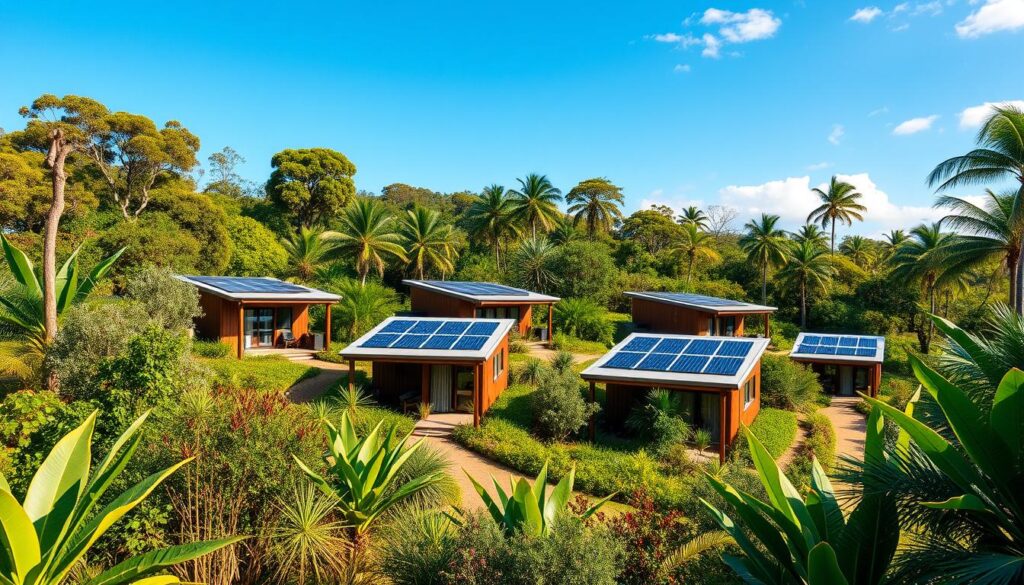
Benefits of Sustainable Modular Homes for Queensland Residents
Queensland’s climate and landscape are perfect for sustainable modular homes. These homes offer many benefits, like adapting to the climate and saving money.
Adaptation to Queensland’s Tropical Climate
Sustainable modular homes in Queensland are made to handle the tropical weather. They have large lots for plenty of outdoor. This makes indoor and outdoor living areas blend together.
Net-zero modular homes use smart designs. They help keep the home cool and reduce heat gain.
Affordable Housing Solutions for Regional Areas
Off-grid modular homes are a budget-friendly option for regional Queensland. They are made in a controlled environment. This cuts down on waste and labor costs.
With over 20 years of experience, builders can find quality materials at good prices. This makes modular homes a smart choice for those watching their budget.

Disaster Resilience in Cyclone-Prone Areas
Tiny modular homes in Queensland are built to last through tough weather. They are stronger than regular houses. They can handle being moved and can stand up to cyclones.
Energy Savings in Queensland’s Hot and Humid Environment
Sustainable modular homes are great at saving energy. They use the latest tech for cooling and ventilation. This cuts down energy use in Queensland’s climate.
This means big savings for homeowners over time.
| Feature | Benefit |
|---|---|
| Controlled Construction | Superior quality, weather-protected build |
| Efficient Design | Reduced material waste, lower costs |
| Quick Build Time | As little as 14 weeks from start to finish |
| Customization | Tailored floor plans and finishes |
| Minimal Site Impact | Fewer ground penetrations required |
Leading Builders of Sustainable Modular Homes in Queensland
Queensland’s modular homes are getting greener fast. Many companies are leading the way with eco-friendly homes. They offer homes that save energy and are good for the planet.
Top Modular Home Companies Operating in Queensland
Oly Homes is a top choice for energy-efficient homes in Queensland. They have homes from small flats to big family homes. People love Oly Homes for their design, colors, and service.
Dream Modular has over 25 years of experience. They make building easy and fast. Their homes are good for the environment and use less energy.
What to Look for in a Sustainable Modular Home Builder
When picking a builder, look for these things:
- Experience in the local climate
- Use of sustainable materials
- Energy-efficient design features
- Customization options
- Customer satisfaction ratings
Examples of Successful Modular Housing Projects in Queensland
Sunshine Tiny Houses shows what’s possible with modular homes. Their homes use solar power and collect rainwater. They’re perfect for different needs in Queensland:
| Location | Purpose | Key Features |
|---|---|---|
| Brisbane | Urban living for young professionals | Proximity to city, lower utility bills |
| Sunshine Coast | Holiday homes, Airbnb rentals | Beach access, relaxed lifestyle |
| Gold Coast | Retirement downsizing | Surf beaches, vibrant community |
| Cairns | Eco-tourism accommodations | Near Great Barrier Reef, nature-filled lifestyle |
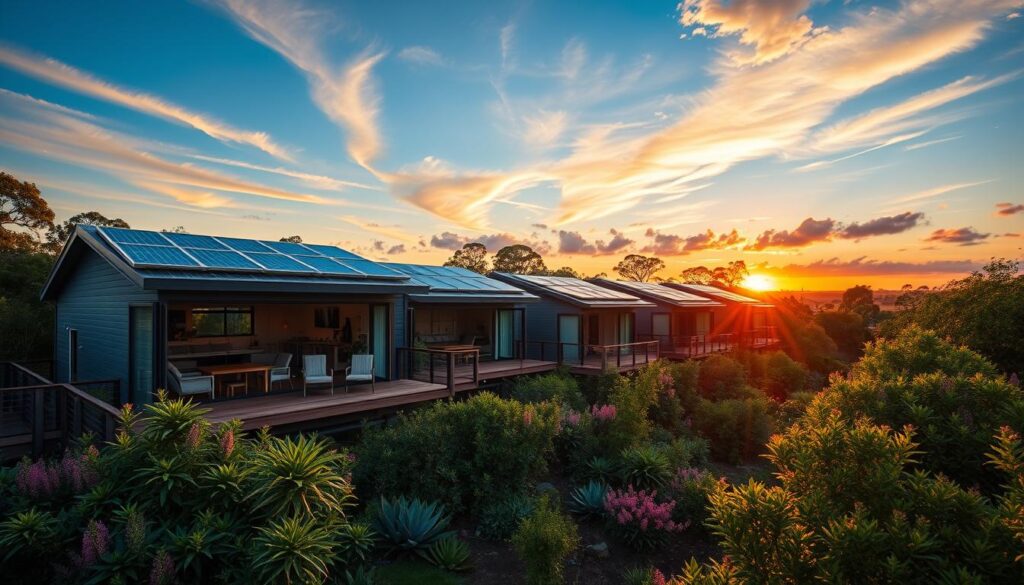
Comparing Local vs. Interstate Modular Builders
Local builders like Oly Homes know Queensland’s climate well. They offer homes for the beach, with special features. Interstate builders may have different designs but might not know the local climate as well.
“Modular building is the future of housing, redefining how Australians will live moving forward.” – Dream Modular
Choosing a local or interstate builder, make sure they focus on sustainability. They should build homes that save energy and last for years in Queensland.
Sustainable Features in Modular Homes Designed for Queensland
Queensland’s climate needs special solutions for living green. Australian modular home builders are making eco-friendly homes for the region. These homes use new tech and smart design for affordable, sustainable living.
Energy-Efficient Cooling Systems
Modular homes in Queensland have cool tech for the heat. They have:
- Passive solar design
- Natural ventilation
- Energy-efficient air conditioning
These features keep homes cool and use less energy.
Solar Integration and Battery Storage Solutions
Off-grid homes are popular in Queensland. They have solar panels and battery systems. This lets people make and save their own clean energy. This way to use energy cuts down on bills and keeps power on when it’s out.
Water Management Systems for Queensland Properties
Using water wisely is key in Queensland. Modular homes often have:
- Rainwater harvesting systems
- Greywater recycling
- Water-efficient appliances
These help save water and lessen the load on local resources.
Durable Materials for High-Humidity and Cyclone Zones
Queensland’s weather is tough, but modular homes are built strong. They use:
- Corrosion-resistant metals
- Moisture-resistant materials
- Impact-resistant windows
| Feature | Benefit | Environmental Impact |
|---|---|---|
| Passive Solar Design | Reduced cooling costs | Lower energy consumption |
| Solar Panels | Energy independence | Reduced carbon emissions |
| Rainwater Harvesting | Lower water bills | Conservation of water resources |
| Durable Materials | Longer home lifespan | Less frequent replacements, reduced waste |
The Costs of Building Sustainable Modular Homes in Queensland
Building sustainable modular homes in Queensland is a smart choice. It’s affordable and good for the planet. The cost depends on several things, so it’s good to know before you start.
Factors Affecting the Cost of Modular Homes in Queensland
The price of these homes changes based on size, design, and materials. A one-bedroom home starts at $180,000. A two-bedroom home starts at $285,000. These prices include full installation, making them a good deal.
Comparing Costs Across Queensland Regions
Prices can change in different parts of Queensland. Coastal areas need extra features for cyclones. Inland areas might need better insulation. Always talk to local builders who know the area well.
| Home Type | Starting Price | Estimated Annual Return | ROI Percentage |
|---|---|---|---|
| One-bedroom (1 module) | $180,000 | $16,000 | 8.9% |
| Two-bedroom (2 modules) | $285,000 | $26,000 | 9.1% |
Financing and Grants for Sustainable Housing in Queensland
Queensland has many incentives for green homes. Look into grants for net-zero homes. Some lenders offer green loans with good terms for these homes, making it easier to invest.
Long-Term Cost Savings of Sustainable Modular Homes
Sustainable modular homes save money in the long run. They have a 7-star energy rating, saving up to 30% on yearly costs. Building them fast and with less waste also saves money and is better for the planet.
“Sustainable modular homes in Queensland offer a unique blend of affordability, efficiency, and environmental stewardship. They’re not just homes; they’re investments in a greener future.”
Choosing sustainable modular homes in Queensland saves money and helps the planet. It’s a smart choice for a greener future in the Sunshine State.
Choosing the Perfect Location for a Modular Home in Queensland
Finding the right place for your prefabricated green home in Queensland is key. The Sunshine State has many spots, each with its own benefits for green homes. Let’s look at what to think about when choosing your spot.
Coastal vs. Inland: Pros and Cons
Queensland’s coast is great for sustainable living. It has cool sea breezes that help keep homes cool. Inland places might be cheaper but need more cooling. Your choice depends on what you value more.
Local Infrastructure Impact
Infrastructure is important for modular homes. Look for easy roads, power, and water. Some places might need more setup, which could affect your budget.
Land Suitability for Modular Homes
Not all land is good for modular homes. Think about:
- Soil type and stability
- Flood risk
- Bushfire prone areas
- Local zoning laws
Do your homework to make sure your land fits with Queensland’s green goals.
Sustainable Community Developments
Some parts of Queensland are all about eco-friendly living. These places welcome green homes and share green features. They’re perfect for those who want to live with others who care about the planet.
“Choosing the right location is as important as the home itself. It sets the foundation for your sustainable lifestyle in Queensland.”
Find a spot that fits your needs and practical stuff. Take your time to look around and talk to local experts. This will help you choose the best place for your modular home in Queensland.
Common Challenges of Modular Homes in Queensland
Building affordable homes in Queensland is tough. Modular builders in Brisbane face many challenges. They aim to create homes that are both green and meet local rules.
Navigating Zoning Laws and Building Codes
Zoning laws and building codes change in Queensland. Builders must work with local councils to follow these rules. This can be hard, especially in areas at risk of floods or bushfires.
Transportation Challenges for Modular Units
It’s hard to move big modular units around Queensland. Swanbuild solves this by building homes almost ready in their factory. This way, they need less special equipment when moving.
Overcoming Climate-Specific Construction Hurdles
Queensland’s weather is different everywhere. Homes must be strong against cyclones, bushfires, and floods. This is a big challenge for builders.
- Cyclone-prone areas need strong homes
- Bushfire Attack Level (BAL) ratings are important
- Flood-resistant designs are key in some places
Misconceptions About Modular Housing in Queensland
Many people still think old-fashioned things about modular homes. Here’s how they compare to traditional homes:
| Feature | Modular Homes | Traditional Homes |
|---|---|---|
| Construction Time | Up to 50% faster | Longer build times |
| Environmental Impact | Less waste | More on-site waste |
| Quality Control | Controlled factory environment | Variable on-site conditions |
| Warranty | Typically 2+ years | Often 1 year or less |
Despite their benefits, modular homes face market doubts and extra costs. It’s important to teach buyers about the value of green homes.
Future of Sustainable Modular Homes in Queensland
The future of sustainable modular homes in Queensland looks bright. The state government is taking big steps to solve housing shortages. Premier Steven Miles has announced plans to build 600 modular homes. This is part of a AU $2.8-billion plan to help regional communities.
Emerging Technologies in Modular Housing
Off-grid modular homes are becoming more popular. They use new technologies like cross-laminated timber and structurally insulated panels. This reduces carbon emissions a lot.
The construction industry is a big source of carbon emissions. So, using sustainable materials is key for Queensland’s future.
Predictions for Housing Trends in Queensland
Experts think more people will choose prefabricated homes. They expect this to triple in the next three years. Tiny modular homes are also getting more attention for their affordability.
Companies like Dimensions X and Ecoliv offer affordable options. Their homes start at $145,000 and $189,000. This makes sustainable living easier for everyone.
Expanding Modular Homes into Urban Queensland Areas
Modular homes might soon be in urban Queensland too. The Queensland Rapid Accommodation and Apprenticeship Centre (RAAC) in Eagle Farm, Brisbane, is leading this effort. They are building the first prototypes of co-designed homes.
This could change how we build homes in cities.
How Modular Homes Align with Queensland’s Sustainability Goals
Modular homes fit well with Queensland’s green goals. They help reduce waste and energy use. This lowers carbon footprints a lot.
Sustainable Home Magazine says prefabricated homes are growing in Australia. They now make up about 5% of new builds. But, more people are seeing the benefits of modular homes.

